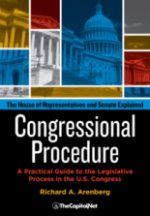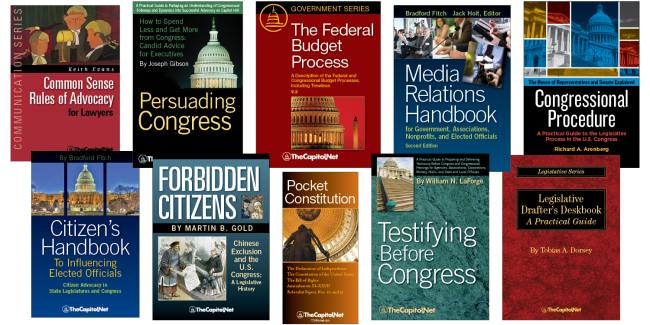From the Congressional Glossary – Including Legislative and Budget Terms
Floor / Aisle / Candy Desk / Gallery

The aisle is the space between the minority and the majority on the floor, i.e., the center aisle. When speaking on the floor, members will occasionally use the phrase “my side of the aisle” to refer to their fellow party members in the chamber.
In the House, members do not have assigned seats. Facing the presiding officer’s dais, by tradition, Democrats sit to the left of the center aisle, and Republicans to the right. Two lecterns are stationed in the well, the open area between the dais and the seats. Each party has two tables on its side of the center aisle of the House.
For Congressional Seating Charts, see CongressSeating.com.
House: from § 6.113, Who Is Allowed on the House Floor? in the Congressional Deskbook:
In addition to the representatives (and formerly House pages), a variety of staff have permanent or temporary privileges to be on the floor of the House. Standing next to or near the presiding officer are the parliamentarian, sergeant at arms, and clerk of the House. At the desk immediately in front of the Speaker are seated the journal clerk, tally clerk, and reading clerk. At the desk below the clerks are the bill clerk, enrolling clerk, and daily digest clerk. Reporters of debate sit at a table below the rostrum. Staff members of committees and individual representatives are allowed on the floor by unanimous consent.
Senate: from § 6.192, Who Is Allowed on the Senate Floor? in the Congressional Deskbook:
In addition to senators, a variety of staff have permanent or temporary privileges to be on the floor of the Senate. At the desk immediately in front of the presiding officer are seated the parliamentarian, legislative clerk, journal clerk, and, often, the executive clerk and bill clerk. Reporters of debates sit at a table below the rostrum. Seats near the rostrum are reserved for the secretary and assistant secretary of the Senate and the sergeant at arms. Majority- and minority-party secretaries and other staff members who have floor privileges may be seen on the floor. Pages sit on either side of the presiding officer’s desk. Staff members of individual senators are allowed on the floor by unanimous consent.
In the Senate, a so-called “candy desk,” filled with sweets, exists on an aisle in the last row on the Republican side of the chamber. The desk is usually assigned to a junior senator (see Junior Senator).

Candy Desk!
In both chambers, the galleries are in the chamber but above the floor. In addition to a gallery for the press (press gallery), there is seating that is used for specific guests such as family members and for other visitors, such as constituents and tourists. See “What’s the Deal With Gallery Passes?”
Also see
- Chamber (CongressionalGlossary.com)
- Congress Seating Charts
- House Floor Plan and Senate Seating Chart
- Seniority / Junior Senator / Senior Senator (CongressionalGlossary.com)
- Mace (CongressionalGlossary.com)
- Well (CongressionalGlossary.com)
- Chapter 4. House Floor and Chapter 5. Senate Floor, in Congressional Procedure
.
More
- House Press Gallery
- Senate Daily Press Gallery
- Senate Media Galleries
- Senate Periodical Press Gallery
- “Congressional News Media and the House and Senate Press Galleries,” CRS Report R44816 (23-page PDF
 )
) - “Guide to Individuals Seated on the House Dais,” CRS Report 98-396 (7-page PDF
 )
) - “Guide to Individuals Seated on the Senate Dais,” CRS Report 98-397 (6-page PDF
 )
) - “House Floor Basics,” Parliamentary Boot Camp (4-page PDF
 )
) - “Secret Sessions of the House and Senate: Authority, Confidentiality, and Frequency,” CRS Report R42106 (11-page PDF
 )
) - Candy Desk – Wikipedia
- “Speaking on the House Floor: Gaining Time and Parliamentary Phraseology,” CRS Report RS22991 (11-page PDF
 )
)
Courses
- Congressional Operations Briefing – Capitol Hill Workshop
- Drafting Federal Legislation and Amendments
- Writing for Government and Business: Critical Thinking and Writing
- Custom Training
- Drafting Effective Federal Legislation and Amendments in a Nutshell, Audio Course on CD
- Congress, the Legislative Process, and the Fundamentals of Lawmaking Series, a Nine-Course series on CD
Publications

Testifying Before Congress |

Pocket Constitution |

Citizen’s Handbook to Influencing Elected Officials: A Guide for Citizen Lobbyists and Grassroots Advocates |

Congressional Procedure |
CongressionalGlossary.com, from TheCapitol.Net
For more than 40 years, TheCapitol.Net and its predecessor, Congressional Quarterly Executive Conferences, have been teaching professionals from government, military, business, and NGOs about the dynamics and operations of the legislative and executive branches and how to work with them.
Our custom on-site and online training, publications, and audio courses include congressional operations, legislative and budget process, communication and advocacy, media and public relations, testifying before Congress, research skills, legislative drafting, critical thinking and writing, and more.
TheCapitol.Net is on the GSA Schedule, MAS, for custom on-site and online training. GSA Contract GS02F0192X
TheCapitol.Net is now owned by the Sunwater Institute.
Teaching how Washington and Congress work ™

 Ferrero Rocher Hazelnut Chocolates, 24 Count
Ferrero Rocher Hazelnut Chocolates, 24 Count Werther’s Original Caramel Hard Candy, 34.0-Ounce Bags
Werther’s Original Caramel Hard Candy, 34.0-Ounce Bags Dove Promises Variety Mix Chocolate Candy 43.07-Ounce 153-Piece Bag
Dove Promises Variety Mix Chocolate Candy 43.07-Ounce 153-Piece Bag Red Bird 320 Count Peppermint Puffs Candy Tub
Red Bird 320 Count Peppermint Puffs Candy Tub